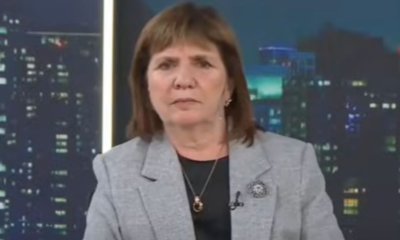INTERNACIONAL
Iran accused of ‘covering up’ death toll in port explosion amid concerns of uprising

FIRST ON FOX: The Islamic Republic of Iran is suspected of «covering up» the true extent of the devastating explosion that rocked the Shahid Rajaee port in Iran’s southern coastal town of Bandar Abbas.
On Tuesday, the death toll reported from Tehran after the explosion had risen to 70, with another 1,200 said to have been injured from the blast. But, according to information from eyewitnesses and the impacts of the blast radius, those figures are expected to be drastically underreported amid concerns of escalating internal unrest, sources have told Fox News Digital.
According to information provided by the National Council of Resistance of Iran (NCRI), the actual death toll from the catastrophic explosion is suspected to be closer to 250, with an estimated 1,500 injured.
People walk after an explosion at the Shahid Rajaee port in Bandar Abbas, Iran, April 26, 2025. (Mohammad Rasoul Moradi/IRNA/WANA via Reuters )
A MASSIVE EXPLOSION AT AN IRANIAN PORT LINKED TO MISSILE FUEL SHIPMENT KILLS 5, INJURES OVER 700
«The true death toll is several times higher than officially reported,» Maryam Rajavi, president-elect of the NCRI, said in a statement. «The IRGC, intelligence forces and other organs of repression have mobilized — not to contain the fires or rescue the wounded — but to control the situation and cover up the shipment of solid fuel for ballistic missiles and the full scale of the disaster.»
The blast originated after a cargo container suspected to be holding sodium perchlorate, a propellant for missiles, including solid fuel in ballistic missiles, apparently caught fire.
Footage of the blast showed the substantial damage caused to shipping containers, nearby offices and a massive crater left by the explosion. Anyone within 200 feet of the blast is believed to have been killed, according to sources.
One witness told the NCRI, «The security situation is very severe. We are all trapped in our homes and have been told not to go outside. The number of casualties is greater than you can imagine. My brother, who works at the dock, said many drivers were pulverized.»
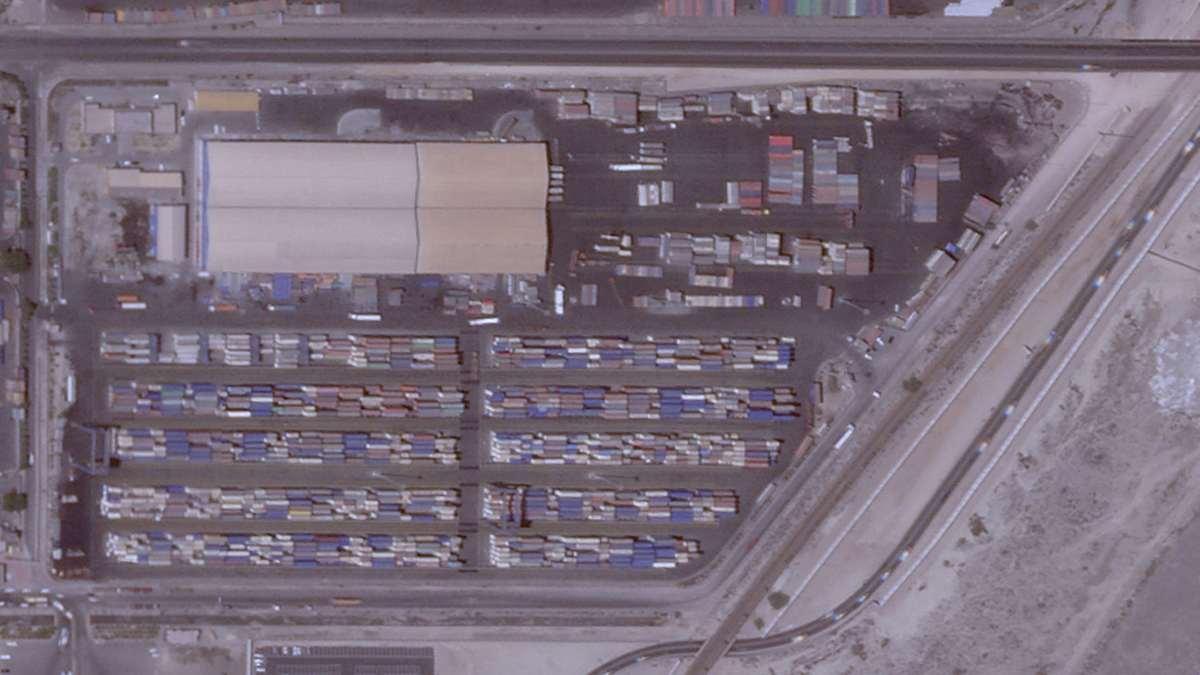
A satellite image shows Shahid Rajaee port in Bandar Abbas, Iran, April 9, 2025. (Planet Labs PBC/Handout via Reuters )
One worker who survived the explosion told the NCRI, «The port and offices no longer exist.»
«The shockwave from the explosion was so strong that it caused colleagues’ eyes to pop out,» the survivor said. «Security forces have closed off the area, and no one is being allowed in.
«In the initial explosion, 15 firefighters were killed. All the staff in the administrative building were also killed.»
TRUMP MARKS 100 DAYS IN OFFICE EMBROILED IN TRADE BATTLES, DEADLY WARS AND HARD PRESSED DEALS
Another survivor accused the regime of «concealing the statistics» by sending Revolutionary Guard forces and intelligence agents to the site of the explosion.
The survivor also pointed out that «chemical and military materials» should not have been at the port to begin with and noted that the workers at the massive site were unaware of its presence.
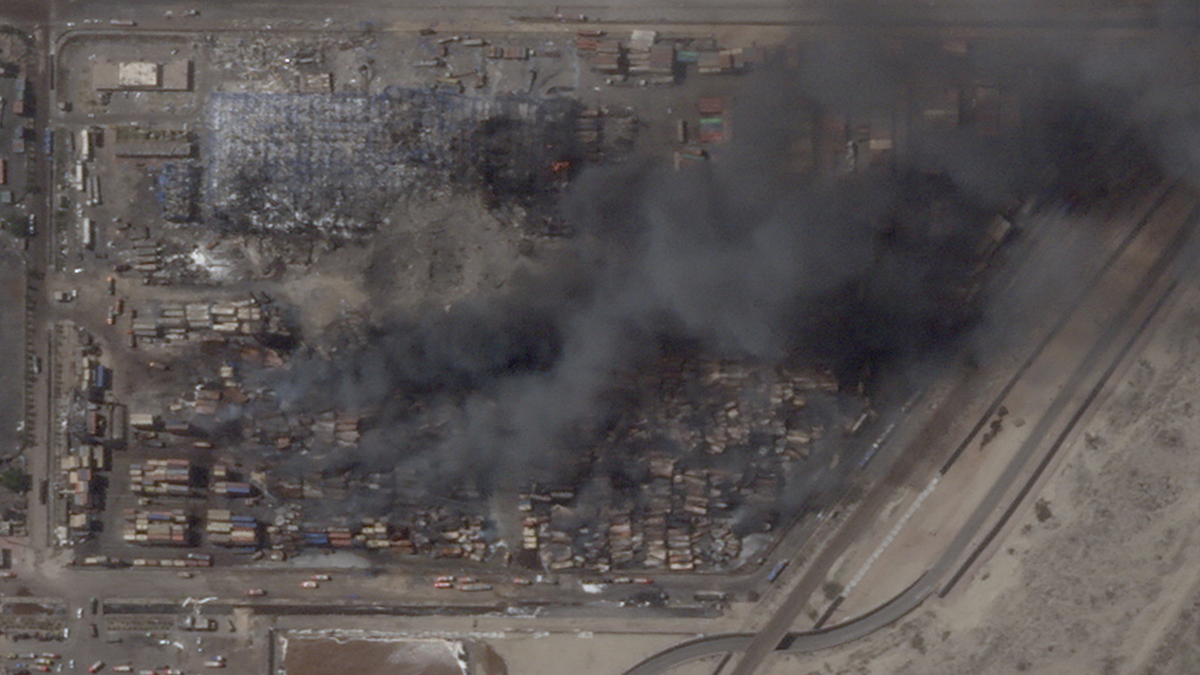
A satellite image shows rising smoke after the previous day’s explosion at the Shahid Rajaee port in Bandar Abbas, Iran, April 28, 2025. (Planet Labs PBC/Handout via Reuters )
Iran’s interior minister said the fire likely started due to «negligence» because the cargo was improperly stored, the BBC reported Tuesday.
Interior Minister Eskandar Momeni said «shortcomings, including noncompliance with safety precautions and negligence» led to the blast.
The officials also said «some individuals deemed responsible» had been summoned, but the regime has yet to admit that any cargo units were holding missile propellant at the civilian shipping center, which is also Iran’s largest port.
The Wall Street Journal in January reported that two solid fuel shipments had been sent from China to Iran, though it is unclear if this cargo had ever been moved off site or if additional sodium perchlorate had been sent to this port.
In a meeting that appeared to take place Sunday between Iranian President Masoud Pezeshkian and regional and port officials, the president appeared to suggest that cargo shipments should not be permitted to stay on site for months at a time and said distribution processes need to be accelerated.
In the aftermath of the explosion, Iran reportedly cordoned off the site, evacuating surrounding areas, placing security agents at local hospitals and accusing the media of perpetuating false stories about the explosion.
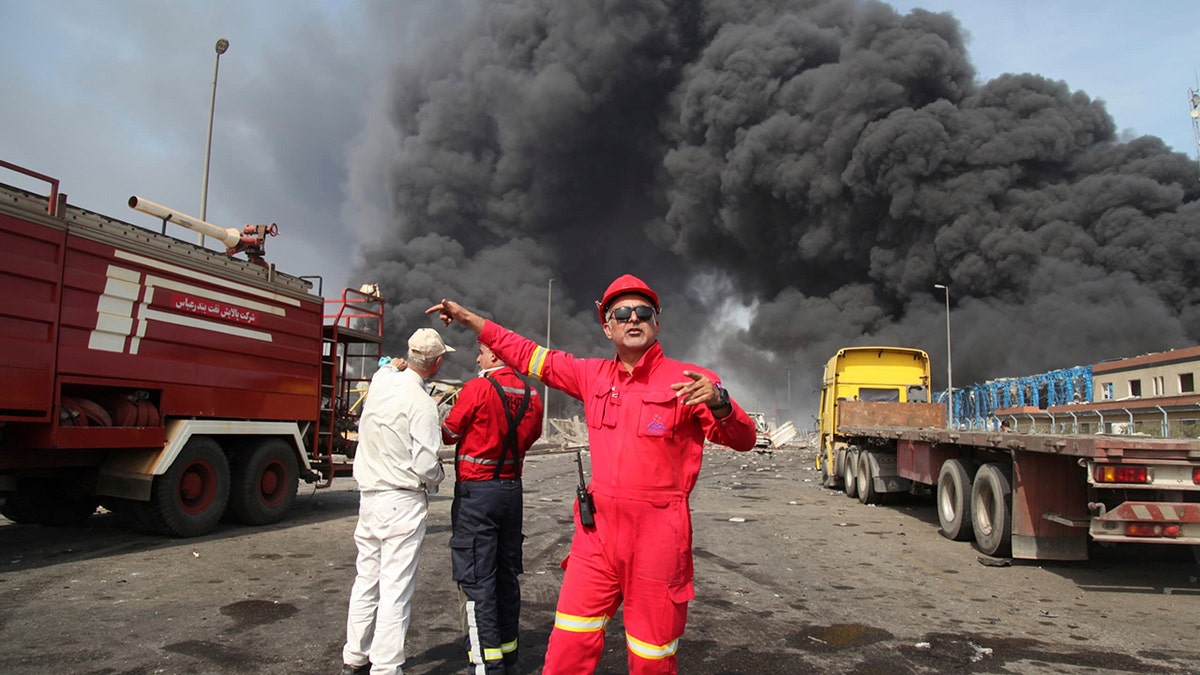
In this photo provided by the Islamic Republic News Agency, firefighters work as black smoke rises in the sky after a massive explosion rocked a port near the southern city of Bandar Abbas, Iran, April 26, 2025. (Mohammad Rasoul Moradi/IRNA via AP)
CLICK HERE TO GET THE FOX NEWS APP
«The sole party responsible for this tragedy is none other than Khamenei’s Islamic Revolutionary Guard Corps (IRGC), whose smuggling of various materials from abroad fuels the manufacture of missiles and other weaponry,» Ali Safavi of the NCRI told Fox News Digital.
«In the face of this disaster, rather than rushing to aid the wounded or recover the bodies of the deceased, the clerical regime — gripped by fear of a public outcry — has instead issued stern warnings against the dissemination of news, images and videos of the explosion, threatening severe legal repercussions against those who dare to expose the truth.»
INTERNACIONAL
Hillary Clinton sounded alarm on Biden’s political viability ‘by 2024,’ Klain told House investigators

NEWYou can now listen to Fox News articles!
Ex-President Joe Biden’s former chief of staff Ron Klain told House investigators that Hillary Clinton approached him with concerns about the octogenarian leader’s political viability «by 2024,» Fox News Digital has learned.
Klain spoke with staff on the House Oversight Committee for over five hours on Thursday, as Committee Chairman James Comer, R-Ky., continues to probe whether top Biden aides concealed signs of mental decline in the ex-president.
A source familiar with his voluntary interview told Fox News Digital that Klain believed Biden was mentally sharp enough to serve as president, and was not too old to run.
But the ex-secretary of state and former Biden national security adviser Jake Sullivan both «approached Ron Klain stating they believed Joe Biden was not politically viable» months before he dropped his re-election bid in July 2024, the source said.
COMER DISMISSES BIDEN DOCTOR’S BID FOR PAUSE IN COVER-UP PROBE: ‘THROWING OUT EVERY EXCUSE’
Former Secretary of State Hillary Clinton shared concerns about ex-President Biden’s political viability by 2024, a source said. (Getty Images)
Sullivan told Klain that Biden «was less effective in 2024 compared to 2022,» the source said.
It’s not immediately clear if Biden’s mental acuity was the reasoning for their doubts, nor if they made the case to Klain together or separately.
But it’s a significant indictment coming from top national Democrats of Biden in general, long before concerns about his fitness for office within the party were made public knowledge.
Sullivan had been a top aide to both Biden and Clinton, having served as the latter’s senior policy advisor during her 2016 campaign.
Klain, who served as White House chief of staff for the first half of Biden’s term, conceded that the then-president was less energetic and more forgetful, though he defended his «acuity to govern,» the source said.
«Mr. Klain stated that President Biden often confused names and proper nouns, and it got worse over time,» the source said.
Fox News Digital was told that Klain also said there was no reason to doubt President Donald Trump’s own mental fitness.

Ron Klain, former White House chief of staff, allegedly made the revelation to House investigators (Andrew Harrer/Bloomberg via Getty Images)
Klain said nothing to reporters when going in or out of the committee room Thursday.
He’s the sixth former Biden administration aide to appear for Comer’s probe.
And despite the interview being largely staff-led, Comer did make an appearance for the early half of the sit-down, and Reps. Andy Biggs, R-Ariz., and Ro Khanna, D-Calif., were both briefly there as well.
Both Biggs and Khanna called Klain «credible» from what they saw inside the room.
«I think he is telling what he knows accurately,» Biggs told Fox News Digital.
FAR-LEFT FIREBRAND SAYS SHE ‘NEVER HAD A CONCERN’ ABOUT BIDEN’S MENTAL STATE AS HOUSE PROBE HEATS UP
On the other side of the aisle, Khanna told reporters, «He answered every single question. He was fully cooperative.»
Three other former Biden White House aides who previously appeared – Annie Tomasini, Anthony Bernal, and ex-White House doctor Kevin O’Connor – all appeared under subpoena and pleaded the Fifth Amendment to avoid answering questions.
Longtime Biden aide Ashley Williams and ex-staff secretary Neera Tanden, like Klain, came for voluntary transcribed interviews.

House Oversight and Accountability Committee Chairman James Comer is leading the probe into Biden. (Anna Moneymaker/Getty Images)
Jeff Zients, who served as Biden’s chief of staff for the final two years, was also asked to sit for a transcribed interview, a committee aide previously told Fox News Digital.
CLICK HERE TO GET THE FOX NEWS APP
A source familiar with the Biden team’s thinking previously called Republicans’ probe «dangerous» and «an attempt to smear and embarrass.»
«And their hope is for just one tiny inconsistency between witnesses to appear so that Trump’s DOJ prosecute his political opponents and continue his campaign of revenge,» that source said.
When reached for comment, Adrienne Watson, a representative for Sullivan, told Fox News Digital, «Jake did not have a conversation with Ron about Joe Biden running for president before the debate.»
Fox News Digital also reached out to Klain’s attorney as well as a contact for comment for Clinton but did not hear back by press time.
INTERNACIONAL
Un respiro para Pedro Sánchez: estalla un escándalo de corrupción de un ex ministro del Partido Popular de España

De viaje oficial por América del Sur -donde esquivó la Argentina por su falta de sintonía con el presidente Javier Milei-, Pedro Sánchez celebró, a la distancia, los dos años desde las últimas elecciones generales que le permitieron volver a ser elegido jefe del gobierno de España en julio de 2023.
Desde hace meses, las investigaciones judiciales que agobian a su entorno le dejan poco margen para festejar.
Porque a las denuncias presentadas contra su esposa, Begoña Gómez, por presunto tráfico de influencias, y a la imputación de su hermano, David Sánchez, por haber ocupado un puesto en la Diputación de Badajoz presumiblemente diseñado a medida para él, se suman la causa contra el fiscal general del Estado, por posible revelación de secretos, y la corrupción que involucra a dos ex altos funcionarios del Partido Socialista que Sánchez lidera por haber cobrado coimas en la adjudicación de obras públicas a empresas privadas.
Esta causa apunta al ex ministro de Transportes, José Luis Abalos, a un ex chofer suyo y asesor, Koldo García, y al ex secretario de organización del PSOE, Santos Cerdán, en prisión preventiva desde fines del mes pasado.
Con este peso sobre sus espaldas, Pedro Sánchez llegó a las puertas del verano europeo con el último aliento de resistencia a las presiones de la oposición para que presente su renuncia y convoque nuevas elecciones.
Hasta que hace unos días, el levantamiento del secreto de sumario de una investigación abierta en 2018 contra un ex ministro del Partido Popular (PP), la principal fuerza de la oposición, le dio un respiro al presidente Sánchez.
Cristóbal Montoro, ministro de Hacienda en el gobierno de José María Aznar, entre abril de 2000 y abril de 2004, y en el mandato de Mariano Rajoy, entre diciembre de 2011 y junio de 2018, está acusado de manipular leyes a medida para beneficiar a empresas privadas.
Las compañías presuntamente favorecidas con la legislación que Montoro se habría ocupado de hacer modificar o aprobar eran clientas de un estudio de abogados que el mismo Montoro había fundado antes de ingresar en la función pública como ministro.
“El uso de tales potestades habría permitido a Equipo Económico (el estudio que el ex ministro abrió en 2008) poder ofrecer a sociedades de distintos sectores reformas que beneficiasen sus intereses económicos, en menoscabo del sector público”, señala el auto del juez Rubén Rus, titular del Juzgado de Instrucción 2 de Tarragona, que acaba de hacerse público.
Según el juez, las empresas dedicadas al rubro energético del gas que contrataron al estudio de Montoro entre 2011 y 2019 habrían desembolsado unos 780 mil euros por sus servicios.
“Quien tiene que dar explicaciones, en sede judicial, es el señor Montoro”, defendió al PP la vocera del partido en el Congreso, Ester Muñoz.
“Por supuesto, van a intentar que esto parezca que es un empate”, agregó Muñoz en alusión al caso de corrupción dentro del Partido Socialista que le borró la sonrisa de la cara a Pedro Sánchez.
“Conviene no insultar a la inteligencia de los españoles -agregó la portavoz del PP-. Porque el caso Koldo (como se conoce en España al cobro de coimas de los ex funcionarios socialistas) afecta al gobierno actual.”
Las malas noticias para el Partido Popular, sin embargo, no terminan aquí. Noelia Núñez, una joven diputada del PP con proyección dentro del partido, acaba de renunciar a sus cargos políticos luego de admitir que en su currículum (CV) figuran estudios que nunca terminó.
Nuñez había sido elegida vicesecretaria de Movilización y Reto Demográfico del PP y en el CV que presentó en el Congreso de los Diputados y en otros organismos oficiales figuraba como licenciada. A veces en Derecho, en otras ocasiones, en Estudios Ingleses. Incluso llegó a adjudicarse un doble grado en Derecho y en Ciencias Jurídicas de las Administraciones Públicas en la UNED (Universidad Nacional de Educación a Distancia). Finalmente se supo que no se graduó en ninguna de las especializaciones de cuyos títulos académicos presumía.
“Con mi decisión muestro el camino a todos aquellos dirigentes socialistas que, con bastante más que esconder o tapar, siguen aferrados a sus cargos y sobreviven en política confiando en la amnesia de la gente o el engaño de los ciudadanos”, señaló la ex diputada en su renuncia, aludiendo al principal argumento de su partido: que Pedro Sánchez debería abandonar el Palacio de la Moncloa.
INTERNACIONAL
Rosas negras y ruinas sumergidas: así es Halfeti, la ciudad escondida en el Éufrates que resurgió entre el mito y la modernidad
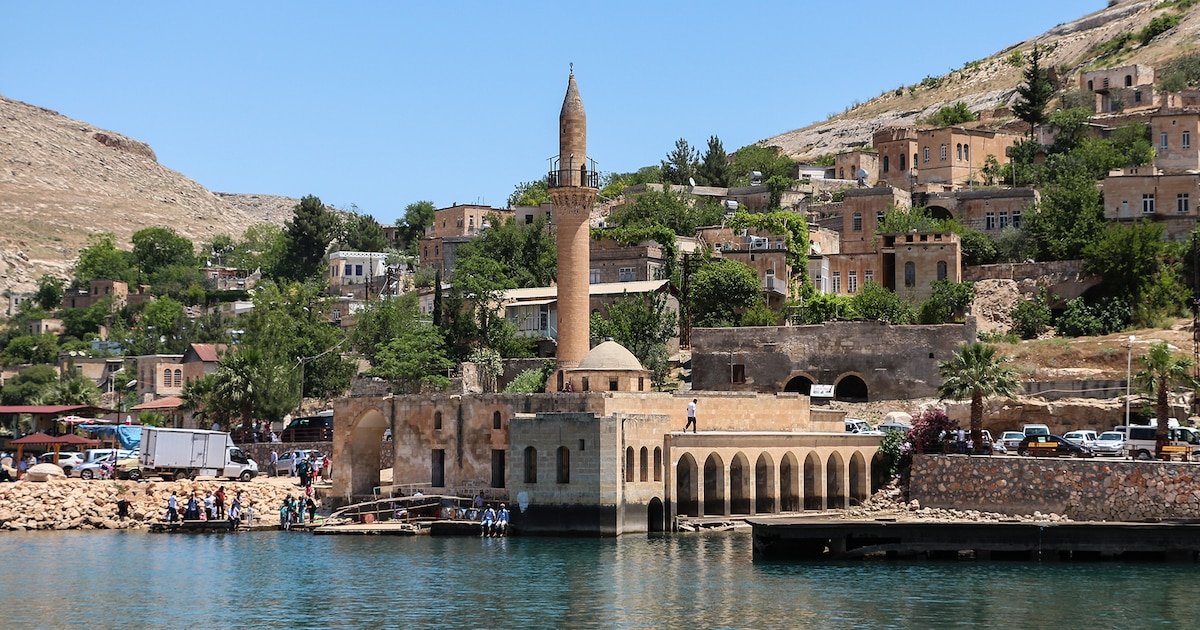
En el sureste de Turquía, a orillas del legendario río Éufrates, una ciudad emerge parcialmente de las aguas, envuelta en misterio y leyendas.
Halfeti, conocida como la “ciudad sumergida”, tuvo que transformar radicalmente su fisionomía tras quedar parcialmente bajo el agua por la construcción de la presa de Birecik, en el año 2000.
Actualmente, este enclave no solo atrae a visitantes por su singular paisaje y arquitectura sumergida, sino que también fascina al mundo con el enigma de sus famosas “rosas negras“, flores que han dado lugar a mitos, debates científicos y un renovado sentido de identidad local, según reportó CNN Travel.

A principios del nuevo milenio, la construcción de la presa de Birecik, una estructura de 60 metros de altura y 2,4 kilómetros de ancho, provocó la inundación de dos pueblos y diez aldeas en la provincia de Sanliurfa.
Según consignan medios locales, alrededor del 40% de Halfeti, que contaba con unos 2.600 habitantes, quedó sumergido bajo las aguas. Entre las edificaciones perdidas se encontraban numerosas casas de piedra, comercios y una parte significativa de la Merkez Camii, la mezquita central del siglo XIX.
La presa de Birecik forma parte de un ambicioso plan de desarrollo para el sureste de Anatolia, que incluye varias de estas estructuras a lo largo de los ríos Éufrates y Tigris. Su embalse, de 52 kilómetros cuadrados, se diseñó para regar 70.000 hectáreas de tierras agrícolas y generar unos 2.500 GWh de electricidad al año, suficiente para abastecer a casi un millón de hogares turcos.

Sin embargo, el impacto en la población local fue profundo y, en muchos casos, doloroso. Más de 6.000 personas tuvieron que ser reubicadas, y la comunidad perdió parte de su patrimonio tangible e intangible. Erhan Yildirim, investigador local, historiador y guía profesional, expresó a CNN Travel: “No se puede recuperar la cultura; la cultura permanece bajo el agua”.
Antes de la inundación, la economía de esta población era, básicamente, agropecuaria, con una reputación especial por la producción de pistachos. Muslum Karaman, operador de barco local, relató a CNN Travel que “la gente de Halfeti solía ganarse la vida con la cría de ganado y la agricultura”. Sin embargo, la llegada de la presa y la consiguiente transformación del entorno los obligaron a buscar nuevas formas de subsistencia.
Karaman explicó que la ciudad “ha cambiado completamente hacia el turismo“, y que muchos habitantes han adaptado sus viviendas para convertirlas en restaurantes, boutique y cafeterías. Esta reinvención económica le permitió a la comunidad mejorar su calidad de vida y aprovechar el creciente interés de los visitantes por la singularidad de Halfeti.

En la actualidad, Halfeti se posiciona como un destino turístico singular. Los visitantes llegan atraídos por la posibilidad de recorrer en barco, moto acuática o flyboard la arquitectura sumergida de la ciudad antigua.
El buceo se ha convertido en una de las actividades favoritas, impulsada por la apneísta turca Şahika Ercümen, quien en 2020 realizó una inmersión en Halfeti para sensibilizar sobre la contaminación por plásticos.
Además de la arquitectura sumergida, los turistas pueden realizar excursiones en barco hasta la fortaleza de Rumkale, situada a orillas del Éufrates. Este sitio histórico, cuyos cimientos datan del Imperio bizantino, permite a los visitantes explorar restos de fortificaciones armenias y conocer la compleja historia de la región, marcada por el paso de diferentes civilizaciones.

Uno de los mayores atractivos de Halfeti es el misterio de sus “rosas negras“, flores que han dado lugar a leyendas y debates científicos. Según la tradición local, es el único lugar del mundo donde florecen.
Yildirim sostiene que “si cultivas la rosa negra en cualquier otro lugar, nunca te dará el mismo color”. No obstante, expertos internacionales cuestionan su existencia. Michael Marriott, reconocido especialista floricultura, declaró a CNN Travel: “No creo que ninguna de las llamadas flores negras sea realmente negra”.
Por otra parte, Guy Barter, horticultor jefe de la Royal Horticultural Society del Reino Unido, coincide en que “las rosas negras, y en general las flores negras, rara vez son completamente negras, si no de un granate muy intenso o, como en este caso, de un rojo muy oscuro”.
El color oscuro de las rosas de Halfeti se atribuye a las condiciones únicas del suelo y el clima de la región. Marriott sugiere que los agricultores locales podrían estar utilizando raíces originales de las rosas, capaces de prosperar en suelos más ácidos, lo que oscurece los pétalos. Birsen Aşağı, vendedora local, atribuye el fenómeno a las “condiciones climáticas de aquí”.

A pesar de las dudas sobre su autenticidad, las rosas negras de Halfeti han adquirido fama internacional. Marcas como la perfumista británica Penhaligon’s han lanzado fragancias inspiradas en la flor, y los productos derivados se han convertido en un símbolo de la ciudad.
Las leyendas locales enriquecen el mito de la rosa negra. Una de ellas narra la historia de Adir, un arquitecto que construyó la mezquita de la ciudad, y su nieta Vartuhi, quien cultivaba las rosas más hermosas.
Vartuhi se enamoró de Firat, un huérfano del otro lado del río, pero su amor fue prohibido. Desesperados, ambos se arrojaron al Éufrates y, desde entonces, las rosas de Halfeti florecen negras en señal de luto.
Otra versión, relatada por Yildirim, atribuye la flor al Diablo, quien, tras el asesinato de una niña inocente, decretó que la rosa negra solo florecería en el lugar de su muerte, como símbolo de dolor y venganza.

A pocos kilómetros del pueblo, la fortaleza de Rumkale se alza como testigo de la historia milenaria de la región. Según CNN Travel, sus cimientos datan del Imperio bizantino, entre los siglos V y VI, aunque existen indicios de estructuras anteriores.
Durante los siglos XII y XIII, la fortaleza fue residencia del Catholicós, líder espiritual de la Iglesia armenia, y posteriormente cayó en manos de los mamelucos en 1292, antes de pasar al control del Imperio Otomano. La arquitectura de Rumkale, visible desde el río, recuerda la compleja y a menudo turbulenta historia de Anatolia, marcada por el cruce de culturas y religiones.
En 2013, Halfeti fue reconocida como parte de la red Cittaslow, un movimiento internacional que promueve la calidad de vida y la preservación de la cultura local.

 ECONOMIA2 días ago
ECONOMIA2 días agoEl consumo en Argentina crece 4% en junio, ante menor inflación y más crédito

 CHIMENTOS2 días ago
CHIMENTOS2 días agoEl desgarrador testimonio del hermano de Locomotora Oliveras: “El daño es irreversible, solo puede vivir con respirador”

 POLITICA2 días ago
POLITICA2 días agoLos organizadores de la Derecha Fest pasaron un video de Villarruel y algunos asistentes gritaron “traidora”















